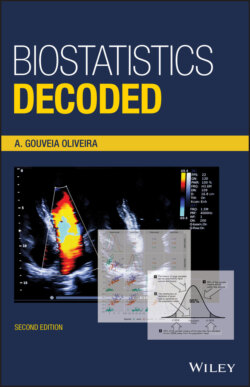Biostatistics Decoded

Реклама. ООО «ЛитРес», ИНН: 7719571260.
Оглавление
A. Gouveia Oliveira. Biostatistics Decoded
Table of Contents
List of Illustrations
Guide
Pages
Biostatistics Decoded
Preface
1 Populations and Samples. 1.1 The Object of Biostatistics
1.2 Scales of Measurement
1.3 Central Tendency Measures
1.4 Sampling
1.5 Inferences from Samples
1.6 Measures of Location and Dispersion
1.7 The Standard Deviation
1.8 The n − 1 Divisor
1.9 Degrees of Freedom
1.10 Variance of Binary Variables
1.11 Properties of Means and Variances
1.12 Descriptive Statistics
1.13 Sampling Variation
1.14 The Normal Distribution
1.15 The Central Limit Theorem
1.16 Properties of the Normal Distribution
1.17 Probability Distribution of Sample Means
1.18 The Standard Error of the Mean
1.19 The Value of the Standard Error
1.20 Distribution of Sample Proportions
1.21 Convergence of Binomial to Normal Distribution
2 Descriptive Studies
2.1 Designing a Research
2.2 Study Design
2.3 Classification of Descriptive Studies
2.4 Cross‐sectional Studies
2.5 Inferences from Means
2.6 Confidence Intervals
2.7 Statistical Tables
2.8 The Case of Small Samples
2.9 Student's t Distribution
2.10 Statistical Tables of the t Distribution
2.11 Inferences from Proportions
2.12 Statistical Tables of the Binomial Distribution
2.13 Sample Size Requirements
2.14 Longitudinal Studies
2.15 Incidence Studies
2.16 Cohort Studies
2.17 Inference from Incidence Studies
2.18 Standardization
2.19 Time‐to‐Event Cohort Studies
2.20 The Actuarial Method
2.21 The Kaplan–Meier Method
2.22 Probability Sampling
2.23 Simple Random Sampling
2.24 Replacement in Sampling
2.25 Stratified Sampling
2.26 Multistage Sampling
3 Analytical Studies. 3.1 Objectives of Analytical Studies
3.2 Measures of Association
3.3 Odds, Logits, and Odds Ratios
3.4 Attributable Risk
3.5 Classification of Analytical Studies
3.6 Uncontrolled Analytical Studies
3.7 Comparative Analytical Studies
3.8 Hybrid Analytical Studies
3.9 Non‐probability Sampling in Analytical Studies
3.10 Comparison of Two Means
3.11 Comparison of Two Means from Small Samples
3.12 Comparison of Two Proportions
4 Statistical Tests. 4.1 The Null and Alternative Hypotheses
4.2 The z‐Test
4.3 The p‐Value
4.4 Student’s t‐Test
4.5 The Binomial Test
4.6 The Chi‐Square Test
4.7 The Table of the Chi‐Square Distribution
4.8 Analysis of Variance
4.9 Partitioning the Sum of Squares
4.10 Statistical Tables of the F Distribution
4.11 The ANOVA Table
5 Aspects of Statistical Tests. 5.1 One‐Sided Tests
5.2 Power of a Statistical Test
5.3 Sample Size Estimation
5.4 Multiple Comparisons
5.5 Scale Transformation
5.6 Non‐parametric Tests
6 Cross‐sectional Studies. 6.1 Linear Regression
6.2 The Least Squares Method
6.3 Linear Regression Estimates
6.4 Regression and Correlation
6.5 The F‐Test in Linear Regression
6.6 Interpretation of Regression Analysis Results
6.7 Multiple Regression
6.8 Regression Diagnostics
6.9 Selection of Predictor Variables
6.10 Independent Nominal Variables
6.11 Interaction
6.12 Nonlinear Regression
7 Case–Control Studies. 7.1 Analysis of Case–Control Studies
7.2 Logistic Regression
7.3 The Method of Maximum Likelihood
7.4 Estimation of the Logistic Regression Model
7.5 The Likelihood Ratio Test
7.6 Interpreting the Results of Logistic Regression
7.7 Regression Coefficients and Odds Ratios
7.8 Applications of Logistic Regression
7.9 The ROC Curve
7.10 Model Validation
8 Cohort Studies. 8.1 Repeated Measurements
8.2 The Paired t‐Test
8.3 McNemar’s Test
8.4 Generalized Linear Models
8.5 The Logrank Test
8.6 The Adjusted Logrank Test
8.7 The Incidence Rate Ratio
8.8 The Cox Proportional Hazards Model
8.9 Assumptions of the Cox Model
8.10 Interpretation of Cox Regression
9 Measurement. 9.1 Construction of Clinical Questionnaires
9.2 Factor Analysis
9.3 Interpretation of Factor Analysis
9.4 Factor Rotation
9.5 Factor Scores
9.6 Reliability
9.7 Concordance
9.8 Validity
9.9 Validation of Diagnostic Tests
10 Experimental Studies
10.1 Main Design Features and Classification
10.2 Experimental Controls
10.3 Replicates
10.4 Classification of Experimental Designs
10.5 Completely Randomized Design
10.6 Interaction
10.7 Full Factorial Design
10.8 The Random Effects Model
10.9 Components of Variance
10.10 ANOVA Model II and Model III
10.11 Rules for the Definition of the Error Terms
10.12 ANOVA on Ranks
11 Blocking. 11.1 Randomized Block Design
11.2 Generalized Randomized Block Design
11.3 Incomplete Block Design
11.4 Factorial Design with Randomized Blocks
11.5 Latin and Greco‐Latin Square Design
12 Simultaneous Inference. 12.1 Multiple Comparisons
12.2 Generalist Methods
12.3 Multiple Comparisons of Group Means
12.4 Pairwise Comparison of Means
12.5 Different Variances
12.6 Comparison to a Control
12.7 Comparison of post hoc Tests
12.8 Complex Comparisons
12.9 Tests of Multiple Contrasts
12.10 A posteriori Contrasts
12.11 The Size of an Experiment
13 Factorial ANOVA. 13.1 The n‐Way ANOVA
13.2 The 2k Factorial Design
13.3 The 2k Factorial Design with Blocking
13.4 The Fractional Factorial Design
14 Nested Designs. 14.1 Split–Plot Design
14.2 Nested (Hierarchical) Design
14.3 Mixed Model Nested ANOVA
14.4 Mixed Model Nested ANOVA with Three Sublevels
14.5 Pure Model II Nested ANOVA
15 Repeated Measures
15.1 Repeated Measures ANOVA
15.2 Repeated Measures ANOVA with Two Factors
15.3 ANOVA with Several Repeated Measures
15.4 Multivariate Tests
16 Clinical Trials. 16.1 Classification of Clinical Trials
16.2 The Clinical Trial Population
16.3 The Efficacy Criteria
16.4 Controlled Clinical Trials
16.5 The Control Group
16.6 Blinding
16.7 Randomization
16.8 Non‐comparative Clinical Trials
16.9 Regression Toward the Mean
16.10 Non‐randomized Controlled Clinical Trials
16.11 Classical Randomized Clinical Trial Designs
16.12 Alternative Clinical Trial Designs
16.13 Pragmatic Clinical Trials
16.14 Cluster Randomized Trials
16.15 The Size of a Clinical Trial
16.16 Non‐inferiority Clinical Trials
16.17 Adaptive Clinical Trials
16.18 Group Sequential Plans
16.19 The Alpha Spending Function
16.20 The Clinical Trial Protocol
16.21 The Data Record
17 Analysis of Clinical Trials. 17.1 General Analysis Plan
17.2 Data Preparation
17.3 Study Populations
17.4 Primary Efficacy Analysis
17.5 Analysis of Multiple Endpoints
17.6 Secondary Analyses
17.7 Safety Analysis
18 Meta‐analysis. 18.1 Purpose of Meta‐analysis
18.2 Measures of Effect
18.3 The Inverse Variance Method
18.4 The Random Effects Model
18.5 Heterogeneity
18.6 Publication Bias
18.7 The Forest Plot
References
Index. a
b
c
d
e
f
g
h
i
k
l
m
n
o
p
q
r
s
t
u
v
w
y
z
WILEY END USER LICENSE AGREEMENT
Отрывок из книги
Second Edition
A. Gouveia Oliveira
.....
Figure 1.15 Two random variables with uniform distribution.
Figure 1.16 Properties of means and variances.
.....